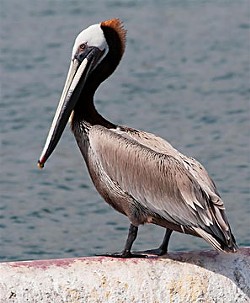[
{
"name": "Top Stories Video Pair",
"insertPoint": "7",
"component": "17087298",
"parentWrapperClass": "fdn-ads-inline-content-block",
"requiredCountToDisplay": "1"
}
]
Humboldt's wintry cold and rain will, I promise, give way to warm and dry weather ... and eventually to long summer evenings. That's when you'll probably find me, around sunset, sitting in my kayak at the south end of Indian Island, cradling a glass of Shiraz and watching one flight after another of pelicans whooshing by inches above my head. On summer evenings they're heading up to their nightly roost around the west end of the Samoa Bridge, flying in V-squadrons or lines of up to about 30 individual birds.
The brown pelican (Pelecanus occidentalis) we see in Humboldt Bay is the smallest of the eight species of pelican, although small is relative: Adults weigh up to 12 pounds and have eight-foot wingspans. They're the only pelicans who dive for fish, as opposed to fishing cooperatively from the surface. After catching the fish -- usually anchovy, here in our bay -- they spend half a minute or so draining the water from the droopy three-gallon pouches below their bills. Then they raise their heads to swallow their catch and take off, paddling and flapping, to start all over. Most of our local pelicans winter on the Mexican coast. I saw hundreds on the Oaxacan coast last month -- before migrating north for summer.
The brown pelican was a major player in getting DDT banned in this country, after the popular-but-persistent insecticide was deemed to be threatening pelican and osprey populations in California and the Southeast in the 1960s. The proof came from a group at the University of Tampa, whichfound that DDT in Tampa Bay was causing pelican eggshells to be overly thin and incapable of supporting the embryo to maturity.
After several lawsuits, DDT was banned by the Environmental Protection Agency in 1972, just 10 years after Rachel Carson had sounded her eloquent warning about the loss of birds in Silent Spring. From 1972 to 1993, the number of breeding pairs of brown pelicans in California soared from 511 to 4,157. Today it's doing so well that it may come off the Endangered Species List.
Despite attribution to Ogden Nash, the following was written around 1910 by Dixon Lanire Merritt, editor of Nashville's paper The Tennessean:
A wonderful bird is a pelican,
His bill will hold more than his belican.
He can take in his beak
Food enough for a week;
But I'm damned if I see how the helican.
Barry Evans ([email protected]) is a recovering civil engineer living in beautiful Old Town Eureka. His book "Everyday Wonders: Encounters with the Astonishing World around Us" led to a four-year stint as a science commentator on National Public Radio.
Comments
Showing 1-1 of 1
more from the author
-
A Brief History of Dildos
- Apr 11, 2024
-
Eclipse!
- Mar 28, 2024
-
The Little Drone that Could
- Mar 14, 2024
- More »
Latest in Field Notes
Readers also liked…
-
Trouble on the Line: The Reality Part 2
- Nov 3, 2022

































